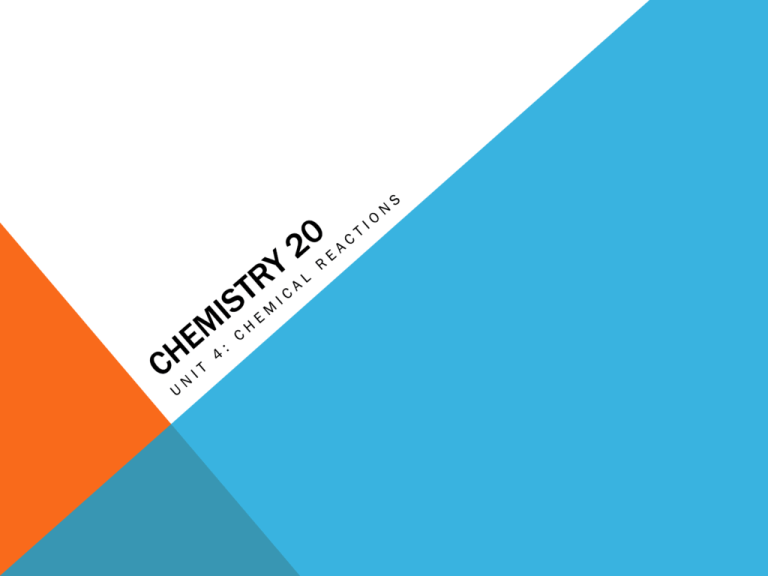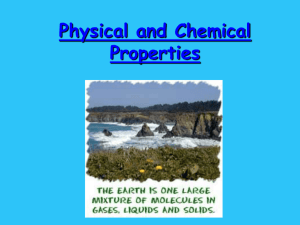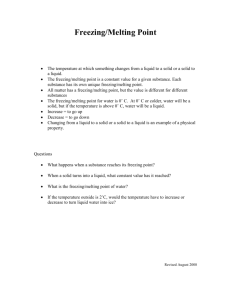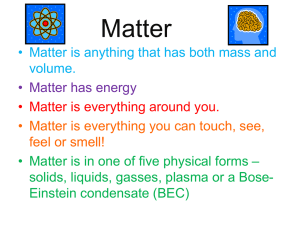unit 4 part 1
advertisement

PHASES OF MATTER! Phase Diagrams Summarizes the effect of temperature and pressure on a substance in a closed container. PHASE DIAGRAM AB line: rate at which solid sublimes to form a gas = rate at which gas condenses to form a solid The points along AB represent all combinations of temperature and pressure at which the solid is in equilibrium with the gas. PRESSURE TEMP DIAGRAM BC line: rate at which liquid boils to form a gas = rate at which gas condenses to form a liquid PRESSURE TEMP DIAGRAM BD line: rate at which solid melts to form a liquid = rate at which liquid freezes to form a solid The BD line is almost vertical because the melting point of a solid is not very sensitive to changes in pressure PRESSURE TEMP DIAGRAM The solid-liquid phase boundary of most substances has a positive slope. This is due to the solid phase having a higher density than the liquid, so that increasing the pressure increases the melting temperature. PRESSURE TEMP DIAGRAM Changes in Pressure: Point B is the point at which a pure substance can exist simultaneously as a solid, a liquid, and a gas. This is called the triple point. PRESSURE TEMP DIAGRAM Point C is the critical point of the substance, which is the highest temperature and pressure at which a gas and a liquid can coexist PRESSURE TEMP DIAGRAM The “normal” boiling point and freezing point occur at 1 atm pressure. EXAMPLE 1. Determine the normal melting point for the substance graphed. 2. Determine the normal boiling point for the substance graphed 3. Determine the temperature and pressure at which the triple point occurs. 4. Is the solid more dense than the liquid? 5. If you had this substance at 1.5atm and 200oC and decreased the pressure to 0.5 atm, what would happen? TEMPERATURE VS. ENERGY GRAPH: Melting Point and Freezing Point Pure, crystalline solids have a characteristic melting point, the temperature at which the solid melts to become a liquid. MP & FP When the solid is turning into a liquid it remains at a constant temperature until all of the solid becomes a liquid. This is because the energy being put into the solid is going into changing the state of the solid and therefore isn’t used to increase the temperature of the compound. Once all of the solid has become a liquid the temperature can increase. MP & FP • Liquids have a characteristic temperature at which they turn into solids, known as their freezing point. In theory, the melting point of a solid should be the same as the freezing point of the liquid. • Melting points are often used to help identify compounds. BOILING POINT When a liquid is heated, it eventually reaches a temperature at which the vapor pressure is large enough that bubbles form inside the body of the liquid. This temperature is called the boiling point. Once the liquid starts to boil, the temperature remains constant until all of the liquid has been converted to a gas. BOILING POINT Pressure and temperature both affect the freezing and boiling points. Below is a chart that shows the freezing and boiling points of water at 1 atm. Examples: 1. What is this substances freezing point? 2. What is it’s melting point? 3. At 80oC, what state of matter is this substance in? 4. At what temperatures is this substance a solid? ASSIGNMENT (See Phase Diagram Assign pg 18 & 19)






